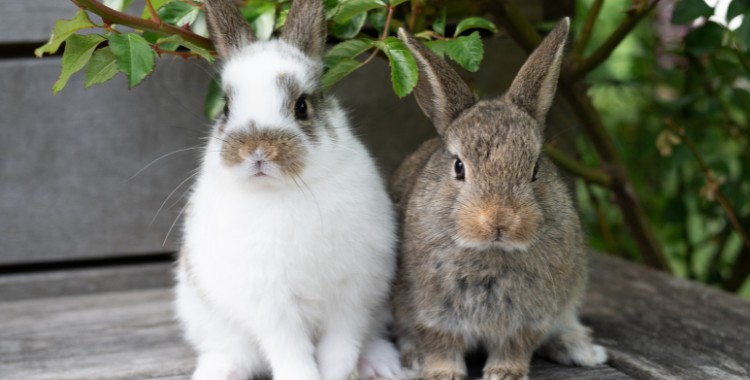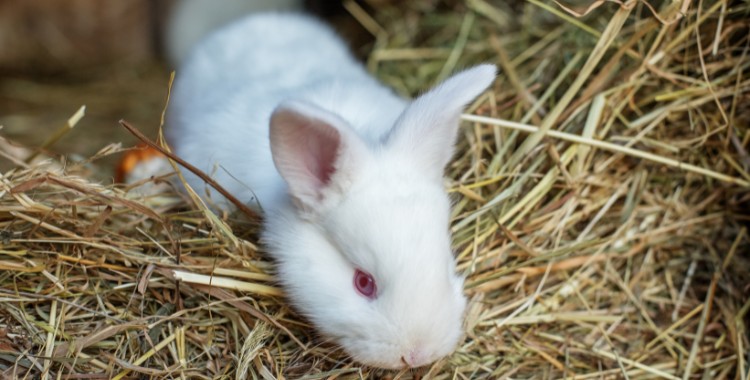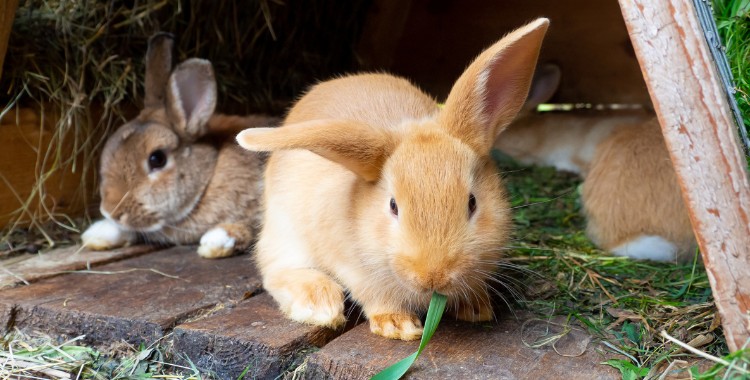Keeping pet bunnies outside can be a delightful experience if done right. At PETS.EDU.VN, we’ll guide you through everything you need to know to ensure your furry friends are safe, happy, and healthy in an outdoor environment. Learn about providing proper shelter, protecting them from predators, and managing temperature fluctuations to create a comfortable and enriching life for your bunnies outdoors. Discover expert tips for outdoor rabbit care, bunny housing, and predator protection, all aimed at enhancing your rabbits’ well-being.
1. What are the Essential Requirements for Keeping Pet Rabbits Outside?
Keeping rabbits outdoors can be a rewarding experience if you provide them with the right environment. To ensure your bunny’s safety and happiness, several key factors must be considered. These include adequate space, protection from predators, appropriate shelter, and environmental enrichment.
- Spacious Enclosure: Rabbits need ample space to exercise and exhibit natural behaviors. A hutch should be large enough for them to stand on their hind legs and hop around comfortably. According to the RSPCA, a suitable hutch should be at least 6ft x 2ft x 2ft for two rabbits.
- Predator Protection: Rabbits are vulnerable to predators, including foxes, cats, and birds of prey. A secure enclosure is essential to protect them. This can be achieved using wire mesh with small openings and ensuring the enclosure is fully covered, including the top and bottom.
- Appropriate Shelter: Rabbits need shelter from the elements, including sun, rain, and wind. Their hutch should be waterproof and provide shade during hot weather. In winter, it should be insulated to keep them warm.
- Environmental Enrichment: Outdoor rabbits need mental stimulation to prevent boredom. Providing tunnels, toys, and items to chew on can keep them entertained and active.
1.1. What are the Key Considerations for Outdoor Rabbit Housing?
Choosing the right type of housing for your outdoor rabbits is crucial for their health and safety. Hutches, runs, and sheds can all serve as suitable homes, provided they meet certain requirements.
| Housing Type | Description | Advantages | Disadvantages |
|---|---|---|---|
| Hutches | Elevated structures with a wire or solid floor, typically made of wood. | Easy to clean, provides some protection from ground predators, can be moved around the garden. | Limited space, may not be suitable for very cold or hot weather without modifications, requires regular maintenance to prevent rotting. |
| Runs | Enclosed areas made of wire mesh, providing a safe space for rabbits to exercise. | Allows rabbits to graze on grass, provides plenty of space for exercise, can be connected to a hutch for easy access. | Offers little protection from the elements, vulnerable to predators if not properly secured, can be difficult to move. |
| Sheds | Solid structures offering excellent protection from the elements and predators. | Provides a secure and weatherproof environment, can be customized with shelves and platforms, offers ample space for multiple rabbits. | Can be expensive to set up, requires good ventilation to prevent respiratory issues, may need insulation to regulate temperature. |
| Modified Dog Kennels | Dog kennels can also be modified to create rabbit enclosures, offering good security and weather protection. | Can be more affordable than custom-built hutches, provides a secure and weatherproof environment. | May require modifications to ensure rabbits cannot escape, ventilation and temperature control are important considerations. |




No matter the housing you choose, ensure it offers protection from the elements, is easy to clean, and provides enough space for your rabbits to move comfortably.
1.2. How Can You Protect Outdoor Rabbits from Predators?
Predator protection is a primary concern when keeping rabbits outdoors. Rabbits can die of fright simply from the presence of a predator. Here are some essential steps to safeguard your bunnies:
- Secure Enclosure: Use heavy-duty wire mesh with small openings (no larger than 1 inch) to prevent predators from entering.
- Covered Top: Ensure the enclosure has a solid or wire mesh top to protect against aerial predators like birds of prey.
- Buried Wire Mesh: Bury the wire mesh at least 12 inches deep around the perimeter of the enclosure to prevent digging predators from burrowing underneath.
- Motion-Activated Lights: Install motion-activated lights to deter nocturnal predators.
- Supervision: Supervise your rabbits whenever they are outside their secure enclosure, especially during dawn and dusk when predators are most active.
According to the House Rabbit Society, rabbits are most vulnerable to predators when they are not properly housed or supervised. Taking these precautions can significantly reduce the risk of predator attacks.
2. What are the Ideal Temperature Ranges for Outdoor Rabbits?
Rabbits are adaptable but can struggle with extreme temperatures. Understanding their ideal temperature range is crucial for keeping them healthy outdoors.
- Ideal Range: The ideal temperature range for rabbits is between 50°F (10°C) and 70°F (21°C).
- Cold Tolerance: Rabbits can tolerate colder temperatures if they have adequate shelter and bedding. However, temperatures below 20°F (-7°C) can be dangerous.
- Heat Sensitivity: Rabbits are highly susceptible to heatstroke. Temperatures above 85°F (29°C) can be life-threatening.
According to a study by the University of Zurich, rabbits are more comfortable in stable temperatures and can experience stress if exposed to rapid temperature changes.
2.1. How Can You Keep Rabbits Warm in the Winter?
Keeping rabbits warm during the winter months requires careful planning and preparation. Here are some effective strategies:
- Insulated Hutch: Insulate the hutch with materials like straw, blankets, or commercial hutch covers.
- Extra Bedding: Provide plenty of extra bedding, such as hay or straw, for rabbits to burrow into.
- Wind Protection: Position the hutch in a sheltered area away from wind and rain.
- Heated Pads: Use pet-safe heated pads or microwaveable heat discs to provide extra warmth.
- Buddy System: If you have multiple rabbits, they can huddle together for warmth.
2.2. How Can You Keep Rabbits Cool in the Summer?
Rabbits are prone to heatstroke, so keeping them cool in the summer is essential. Here are some tips to help your bunnies beat the heat:
- Shade: Provide plenty of shade by positioning the hutch in a shaded area or using tarpaulins or umbrellas.
- Cooling Tiles: Place ceramic tiles or frozen water bottles wrapped in towels inside the hutch for rabbits to lie on.
- Misting: Mist rabbits with cool (not cold) water, focusing on their ears, to help them regulate their body temperature.
- Ventilation: Ensure the hutch is well-ventilated to prevent overheating.
- Fresh Water: Always provide plenty of fresh, cool water.
3. What are the Signs of Heatstroke and Hypothermia in Rabbits?
Recognizing the signs of heatstroke and hypothermia is crucial for providing timely intervention and potentially saving your rabbit’s life.
3.1. Signs of Heatstroke in Rabbits
- Rapid Breathing: Panting or rapid, shallow breaths.
- Lethargy: Weakness or reluctance to move.
- Red Ears: Hot, red ears.
- Salivation: Drooling or excessive salivation.
- Seizures: In severe cases, seizures may occur.
3.2. Signs of Hypothermia in Rabbits
- Shivering: Uncontrollable shivering.
- Cold Ears: Cold ears.
- Huddling: Huddling or curling up tightly.
- Lethargy: Weakness or decreased activity.
- Pale Gums: Pale or bluish gums.
If you notice any of these signs, take immediate action. For heatstroke, move the rabbit to a cool area, offer cool water, and apply cool, wet towels to their ears. For hypothermia, move the rabbit to a warm area, wrap them in a blanket, and offer warm (not hot) water. In both cases, contact a veterinarian immediately.
4. How Do You Introduce Baby Rabbits to the Outdoors?
Introducing baby rabbits to the outdoors requires a gradual and careful approach. Baby rabbits are more vulnerable to temperature changes and predators, so extra precautions are necessary.
- Age: Wait until baby rabbits are at least eight weeks old before introducing them to the outdoors.
- Gradual Exposure: Start with short, supervised visits during mild weather.
- Secure Enclosure: Ensure they are in a secure enclosure that protects them from predators and the elements.
- Familiar Items: Place familiar items, such as toys and bedding, in the outdoor enclosure to help them feel more comfortable.
- Monitor Closely: Monitor their behavior closely for any signs of stress or discomfort.
According to the Veterinary Centers of America, gradual exposure helps baby rabbits acclimatize to the outdoor environment and reduces the risk of stress-related health issues.
5. What are the Best Practices for Feeding Outdoor Rabbits?
Proper nutrition is essential for maintaining the health and well-being of outdoor rabbits. A balanced diet should consist of hay, fresh vegetables, and a small amount of high-quality rabbit pellets.
- Hay: Hay should make up 80-90% of a rabbit’s diet. Timothy hay is a popular choice, but other options include orchard grass and oat hay. Hay provides essential fiber for digestive health.
- Fresh Vegetables: Offer a variety of fresh vegetables daily. Leafy greens like romaine lettuce, kale, and parsley are good choices. Avoid iceberg lettuce and vegetables high in sugar, such as carrots and fruit.
- Rabbit Pellets: Provide a small amount of high-quality rabbit pellets to supplement their diet. Choose pellets that are high in fiber and low in sugar.
- Fresh Water: Always provide plenty of fresh, clean water.
5.1. What are Some Toxic Plants to Avoid in an Outdoor Environment?
Outdoor rabbits may have access to plants that are toxic to them. It’s crucial to identify and remove these plants from their environment. Some common toxic plants include:
- Buttercups
- Daffodils
- Foxglove
- Hemlock
- Lily of the Valley
The ASPCA provides a comprehensive list of toxic and non-toxic plants for rabbits, which can be a helpful resource for ensuring your outdoor environment is safe.
6. How Can You Keep Outdoor Rabbits Entertained?
Rabbits are intelligent and curious animals that need mental stimulation to prevent boredom. Providing a variety of toys and activities can keep them entertained and happy.
- Tunnels: Rabbits love to explore tunnels. You can use cardboard tubes, PVC pipes, or commercial rabbit tunnels.
- Chew Toys: Provide chew toys made of wood, cardboard, or untreated willow branches to help wear down their teeth.
- Digging Box: Create a digging box filled with soil or sand for rabbits to satisfy their natural digging instincts.
- Foraging Toys: Use foraging toys to encourage rabbits to search for food. You can hide treats in cardboard boxes, toilet paper rolls, or commercial foraging toys.
- Social Interaction: Spend time interacting with your rabbits daily. You can play with them, groom them, or simply sit and observe them.
According to a study by the University of Bristol, rabbits that have access to a variety of toys and activities exhibit fewer behavioral problems and are generally happier.
7. What are Common Health Issues for Outdoor Rabbits?
Outdoor rabbits are susceptible to several health issues, including parasites, respiratory infections, and flystrike. Regular health checks and preventative care are essential for keeping them healthy.
- Parasites: Outdoor rabbits are at risk of contracting parasites such as fleas, mites, and worms. Regular deworming and flea/mite treatments are necessary.
- Respiratory Infections: Respiratory infections, such as snuffles, are common in rabbits. Symptoms include sneezing, nasal discharge, and difficulty breathing. Prompt veterinary treatment is essential.
- Flystrike: Flystrike occurs when flies lay eggs on a rabbit’s skin, and the larvae hatch and feed on the rabbit’s flesh. This is a serious and often fatal condition. Prevention involves keeping the rabbit clean and dry, especially around the rear end, and using fly repellent products.
7.1. How to Prevent Flystrike in Outdoor Rabbits?
Flystrike is a severe concern for outdoor rabbits, particularly during the warmer months. Prevention is key to protecting your rabbits from this deadly condition.
- Keep the Hutch Clean: Regularly clean the hutch to remove any urine or feces that may attract flies.
- Check Daily: Check your rabbit daily for any signs of urine scalding or diarrhea, which can attract flies.
- Fly Repellent: Use rabbit-safe fly repellent products to deter flies from laying eggs on your rabbit.
- Wound Care: Treat any wounds or sores promptly to prevent flies from being attracted to them.
- Consult a Vet: If you notice any signs of flystrike, such as maggots on your rabbit, seek veterinary treatment immediately.
8. How Often Should You Clean an Outdoor Rabbit Hutch?
Maintaining a clean hutch is crucial for preventing health problems and ensuring your rabbits are comfortable. The frequency of cleaning depends on the size of the hutch and the number of rabbits.
- Daily Spot Cleaning: Remove soiled bedding and feces daily to prevent odor buildup and reduce the risk of flystrike.
- Weekly Deep Cleaning: Perform a deep cleaning of the entire hutch weekly. Remove all bedding, scrub the hutch with a rabbit-safe disinfectant, and replace with fresh bedding.
- Monthly Disinfection: Disinfect the hutch monthly to kill any bacteria or parasites. Use a rabbit-safe disinfectant and rinse thoroughly before replacing the bedding.
According to the University of California, Davis, regular cleaning and disinfection of rabbit hutches can significantly reduce the risk of disease transmission.
9. What are the Legal Considerations for Keeping Rabbits Outdoors?
Before keeping rabbits outdoors, it’s essential to be aware of any local regulations or restrictions. Some areas may have ordinances regarding the number of rabbits you can keep or the type of housing required.
- Local Ordinances: Check with your local government to determine if there are any ordinances regarding rabbit ownership.
- HOA Restrictions: If you live in a neighborhood with a homeowners association (HOA), check their rules and regulations regarding outdoor pets.
- Animal Welfare Laws: Be aware of animal welfare laws in your area, which may require you to provide adequate food, water, shelter, and veterinary care for your rabbits.
Failure to comply with local regulations can result in fines or other penalties.
10. What Breeds of Rabbits are Best Suited for Living Outdoors?
While most rabbit breeds can adapt to living outdoors with proper care, some breeds are better suited for outdoor living due to their hardiness and coat type.
- New Zealand: New Zealand rabbits are large and hardy, with a dense coat that provides good insulation.
- Flemish Giant: Flemish Giant rabbits are also large and hardy, with a thick coat that helps them tolerate cold weather.
- American Chinchilla: American Chinchilla rabbits have a dense, plush coat that provides excellent insulation.
- Harlequin: Harlequin rabbits are known for their hardiness and adaptability, making them well-suited for outdoor living.
However, even hardy breeds require proper shelter and care to thrive outdoors.
FAQ: Keeping Pet Bunnies Outside
1. Is it cruel to keep a rabbit outside?
It is not cruel to keep a rabbit outside if you provide them with proper shelter, protection from predators, and adequate care. Rabbits can thrive outdoors if their needs are met.
2. Can rabbits be left outside overnight?
Rabbits can be left outside overnight if their enclosure is secure and they have adequate shelter from the elements.
3. Do rabbits get lonely outside?
Rabbits are social animals and can get lonely if kept alone. It’s best to keep rabbits in pairs or small groups to provide companionship.
4. How cold is too cold for rabbits outside?
Temperatures below 20°F (-7°C) can be dangerous for rabbits. Provide extra bedding and insulation during cold weather.
5. How hot is too hot for rabbits outside?
Temperatures above 85°F (29°C) can be life-threatening for rabbits. Provide shade, ventilation, and cooling methods during hot weather.
6. What do outdoor rabbits eat?
Outdoor rabbits should eat a diet consisting of hay, fresh vegetables, and a small amount of high-quality rabbit pellets.
7. How do I protect my outdoor rabbit from predators?
Use a secure enclosure with heavy-duty wire mesh, a covered top, and buried wire mesh to prevent predators from entering.
8. How often should I clean my outdoor rabbit hutch?
Clean the hutch daily by removing soiled bedding and feces. Perform a deep cleaning weekly and disinfect monthly.
9. What are the signs of flystrike in rabbits?
Signs of flystrike include maggots on the rabbit, foul odor, and skin irritation. Seek veterinary treatment immediately if you suspect flystrike.
10. Can indoor rabbits be moved outside?
Indoor rabbits can be moved outside gradually during mild weather. Provide extra bedding and shelter to help them acclimatize to the outdoor environment.
At PETS.EDU.VN, we understand the challenges and joys of caring for outdoor rabbits. Our mission is to provide you with the most accurate and reliable information to ensure your bunnies live happy, healthy lives. For more in-depth guides, personalized advice, and a supportive community, visit PETS.EDU.VN today. Our comprehensive resources cover everything from nutrition and health to behavior and enrichment. Let us help you create the best possible life for your furry friends. Contact us at 789 Paw Lane, Petville, CA 91234, United States, Whatsapp: +1 555-987-6543. Trang web: pets.edu.vn.
